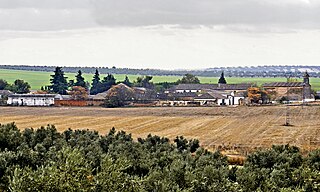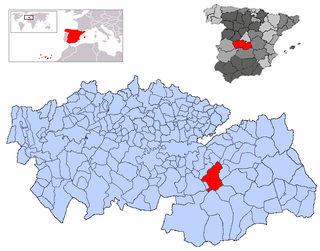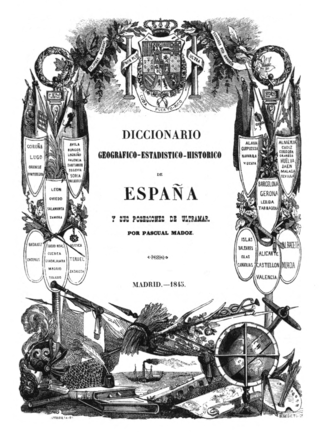
Illán de Vacas is a town in the province of Toledo, in Castile–La Mancha, Spain. The surface area of the municipality is 9 km2, it has a total population of 3 inhabitants, making it the least populated municipality in Spain.

Pascual Madoz Ibáñez was a Spanish politician and statistician.
Jaun Zuria is the mythical first Lord and founder of the Lordship of Biscay, who defeated the Leonese and Asturian troops in the also-mythical Battle of Padura, in which he chased off the invaders to the Malato Tree, establishing there the borders of Biscay. There are three accounts of its legend, one by the Portuguese count Pedro Barcelos and two by the chronicler Lope García de Salazar. According to the legend, Jaun Zuria had been born from a Scottish or English princess who had been visited by the Basque deity Sugaar in the village of Mundaka.

Villel de Mesa is a municipality in the province of Guadalajara, in the autonomous community of Castile-La Mancha, Spain.

Malagón is a municipality in Ciudad Real, Castile-La Mancha, Spain. As of 2010, it has a population of 8,731.

Belmontejo is a municipality in Cuenca, Castile-La Mancha, Spain. It had a population of 250 as at 2014/15.
Olivares is a city located in the Province of Seville, Spain. According to the 2016 census (INE), the city has a population of 9480 inhabitants. It is located in the Aljarafe, the comarca downstream of the Guadalquivir and west of Seville. It borders Albaida to the west, Gerena to the north, Salteras to the east, and Sanlúcar la Mayor and Villanueva del Ariscal to the south. After the establishment of the House of Olivares, it grew in size and influence, becoming an important urban center in the Aljarafe.

Hontalbilla is a municipality located in the province of Segovia, Castile and León, Spain. According to the 2004 census (INE), the municipality has a population of 391 inhabitants.

Villalar de los Comuneros is a municipality located in the province of Valladolid, Castile and León, Spain. According to the 2004 census (INE), the municipality had a population of 449 inhabitants.

Mora is a town and municipality in Toledo province, in the autonomous community of Castile-La Mancha, Spain. The area is most famous for the abandoned ruins of the San Marcos de Yegros monastery of the Order of Santiago, located northeast of the town of Mora about 10 km on the Calle de los Dolores in the village of Paraje de Yegros.
Alarcia is a town of northern Spain, Autonomous Community of Castile and León, province of Burgos, Shire of Montes de Oca, sub-shire of Tirón-Rioja Burgalesa, in the municipality of Rábanos. It lies between the reservoir Úzquiza (west) and the peak of San Millan in the Sierra de la Demanda (southeast).

La Jara is a comarca located in the Montes de Toledo at the western end of Toledo Province, it also includes the municipality of Anchuras, an enclave of the province of Ciudad Real, in Castile-La Mancha, Spain. The comarca's capital is Los Navalucillos, however Talavera de la Reina is an important city for local people in La Jara owing to historical ties, even though it is located outside of the comarca.

Senterada is a village in the province of Lleida and autonomous community of Catalonia, Spain. The municipality includes a small exclave to the north.

Juan Fernández de Híjar y Cabrera was a Spanish noble of the House of Híjar. He was the son of Juan Fernández de Híjar, the fifth Baron of Hijar and first lord of Lécera. His mother was Juan Fernandez' second wife, Timbor de Cabrera, daughter of Bernardo de Cabrera, first Count of Módica, XXIV Viscount of Cabrera, XXVI Viscount of Bas, and II Viscount of Osuna.

The Aqueduct of Algeciras is one of the most important buildings in Algeciras, Spain. Numerous textbooks, dictionaries and guidebooks cite this building as Arabic or Roman, but it was built in the eighteenth century.

The siege of Algeciras (1369) was undertaken during the period of the Reconquest of Spain by Muhammad V, the Emir of Granada to reclaim the city of Al-Hadra Al-Yazirat, called Algeciras by the Christians, in the Kingdom of Castile. The siege lasted just three days, and the sultan was victorious. The Muslims thus regained a major city which had been in Castilian hands since Alfonso XI of Castile took it from the Moroccans after the long 1342–1344 siege. Ten years after the capture of the city, in 1379 the sultan of Granada decided to completely destroy the city to prevent it falling into Christian hands. It was impossible to defend the place at a time when the Muslim kings of the Iberian Peninsula had lost much of military power they enjoyed in earlier centuries.

Amorós is a locality belonging to the municipality of Sant Guim de Freixenet, in the Province of Lleida, Catalonia, Spain. As of 2020, it has a population of 12. A standalone municipality in the past, it was absorbed by the municipality of Sant Guim de Freixenet in between 1842 and 1857. The Madoz dictionary described its location as lying "on a plain with free ventilation and a healthy climate".

Argüébanes is a town in the municipality of Camaleño.

The Diccionario geográfico-estadístico-histórico de España y sus posesiones de Ultramar is a geographic handbook of Spain. Originally published in 16 volumes between 1845 and 1850, it was edited and directed by Pascual Madoz. A widely known work in Spain, used as reference work, it stands out in terms of the sheer amount of information, its systematization as well as for covering the whole geography of Spain.

Verdeña is a settlement in the province of Palencia and is part of the municipality of Cervera de Pisuerga.





















